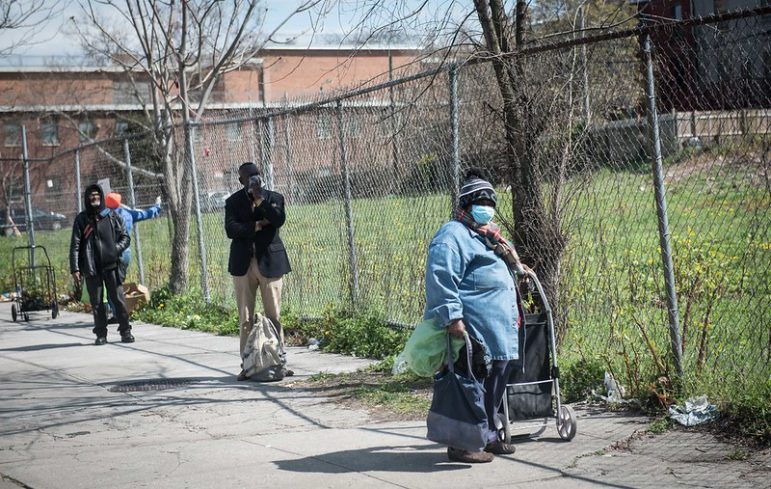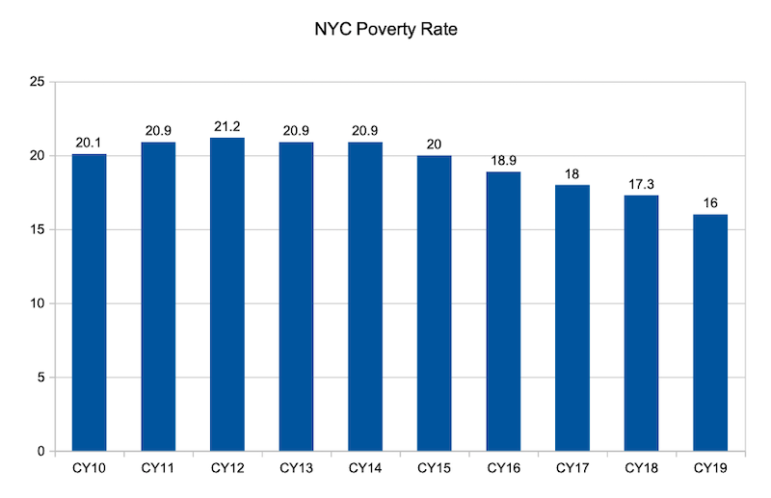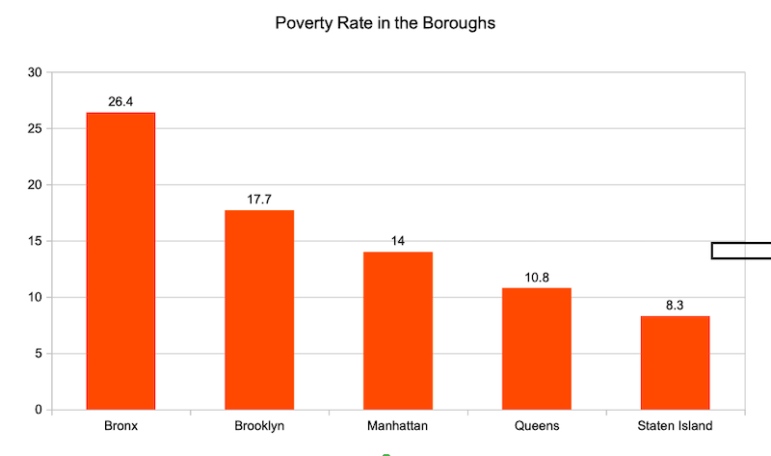The city’s poverty rate fell in 2019. But the events of 2020 have all but certainly reversed that trend.

Michael Appleton/Mayoral Photography Office
Line outside the Campaign Against Hunger food pantry in Brooklyn one day in April.Poverty fell in New York City and state and across the nation in 2019, continuing a five-year trend—one that the COVID-19 pandemic is widely expected to have reversed.
According to the Census Bureau’s American Community Survey, the share of New York City’s population living under the federal poverty line averaged 16 percent in 2019, down from 17.3 percent in 2018 and 20.9 percent five years earlier in 2014.
“These results tell us little about the current grim state of our city,” the Community Service Society of New York said. “Over the last six months, a pandemic and recession have devastated the local economy and laid bare longstanding inequities across the city’s communities and neighborhoods.”

American Community Survey
Since the time when the ACS data was collected, the city’s unemployment rate has quadrupled.
“Unfortunately, these numbers no longer reflect the realities of millions of New Yorkers who are seeing ever increasing economic hardship over the past months as a result of our current economic recession,” Jennifer Jones-Austin, the executive director of the Federation of Protestant Welfare Agencies, said in a statement.
“The unprecedented economic hardships faced by a growing number of New Yorkers highlights both the fragility of the economic gains of recent years and the need for immediate policy interventions to support those who are increasingly struggling to make ends meet,” she continued. “Another robust federal stimulus package will be critical to our economic recovery, and our safety net programs must be shored up in order to ensure that our recovery is fair and reaches the Black and brown communities who have borne the greatest impact of the COVID pandemic and the resulting economic downturn.”
New York State’s poverty rate also fell (from 13.6 in 2018 to 13.0 in 2019), as did the nation’s, from 13.1 percent in 2018 to 12.3 percent in 2019.
Even before the pandemic, steep disparities remained. The poverty rate for Black New Yorkers increased slightly, from 20.0 to 20.5 percent. The Latino poverty rate dropped from 23.7 percent to 20.9 percent, but was still twice the Non-Hispanic White poverty rate of 10.1 percent. Asian poverty declined from 15.4 percent to 14.2 percent.
Every borough saw decreases as well from 2018 to 2019, but they continued to show sharp differences. The Bronx’s poverty rate was 26.4 percent. Brooklyn (17.7 percent) and Manhattan (14 percent) posted rates closer to the citywide average. Queens (10.8 percent) and Staten Island (8.3 percent) had significantly lower rates.
Statistics like the poverty rate always lag reality, and that is not their only shortcoming. The federal poverty rate fails to account for regional differences in prices, the impact of some benefit programs and changes over time in how U.S. families typically spend their money. People with incomes well above poverty can suffer intense economic need. What’s more, movements in the rate can indicate changes in the economic fortunes of a city’s or borough’s residents, or merely reflect the movement of income groups into or out of an area: When people in poverty leave a place, the poverty rate decreases, but that only indicates displacement of poverty, not reduction.
Other ACS statistics paint a more complete and nuanced picture of the city’s economy, which saw its median income rise 7.2 percent in 2019. “Despite the remarkable expansion in the median household income, New York City continues to be the most unequal among all large cities in the country,” CSS (a City Limits funder) noted. “The top five percent of New Yorkers received 28 percent of all incomes generated in the city, while the bottom 20 percent received a mere two percent.”










2 thoughts on “The Good News on NYC Poverty is Old News, Which is Bad News”
America – the richest nation in the world – is a nation of slave-wagers.. food-insecure, shelterless, and 50-million without healthcare.
Only the victims of America’s government from countries in Latin-America.. whose poor have been put down by America’s secret military interventions.. are living in conditions so bad and the crime that results, they’re willing to risk their lives to get into that shit-hole country for the possibility of living a better life at poverty-levels.
..and you’re attacking China.. to keep the minds of the 47% hovering around the poverty level off the fact that the rich need a way.. to keep you down.. because their privatized-system that sucks (cannot even reach full employment).. cannot prevent China’s rise and your shit-hole country cannot compete – since they have already maxed out every avenue of exploitation of the American people possible.
Well blame the government for that.